翻译理论
翻译目的理论
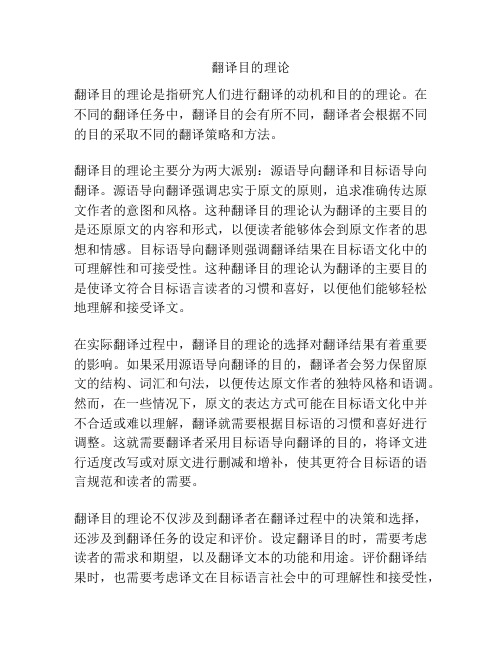
翻译目的理论翻译目的理论是指研究人们进行翻译的动机和目的的理论。
在不同的翻译任务中,翻译目的会有所不同,翻译者会根据不同的目的采取不同的翻译策略和方法。
翻译目的理论主要分为两大派别:源语导向翻译和目标语导向翻译。
源语导向翻译强调忠实于原文的原则,追求准确传达原文作者的意图和风格。
这种翻译目的理论认为翻译的主要目的是还原原文的内容和形式,以便读者能够体会到原文作者的思想和情感。
目标语导向翻译则强调翻译结果在目标语文化中的可理解性和可接受性。
这种翻译目的理论认为翻译的主要目的是使译文符合目标语言读者的习惯和喜好,以便他们能够轻松地理解和接受译文。
在实际翻译过程中,翻译目的理论的选择对翻译结果有着重要的影响。
如果采用源语导向翻译的目的,翻译者会努力保留原文的结构、词汇和句法,以便传达原文作者的独特风格和语调。
然而,在一些情况下,原文的表达方式可能在目标语文化中并不合适或难以理解,翻译就需要根据目标语的习惯和喜好进行调整。
这就需要翻译者采用目标语导向翻译的目的,将译文进行适度改写或对原文进行删减和增补,使其更符合目标语的语言规范和读者的需要。
翻译目的理论不仅涉及到翻译者在翻译过程中的决策和选择,还涉及到翻译任务的设定和评价。
设定翻译目的时,需要考虑读者的需求和期望,以及翻译文本的功能和用途。
评价翻译结果时,也需要考虑译文在目标语言社会中的可理解性和接受性,以及是否能够准确传达原文的意图和信息。
在实际翻译中,翻译目的理论的选择应该基于具体的翻译任务和语境。
有些翻译任务要求忠实于原文的原则,如科技文献的翻译;而有些翻译任务则要求强调目标语言的可理解性和可接受性,如广告和文学作品的翻译。
翻译目的理论可以帮助翻译者在翻译过程中明确自己的目标,选择合适的翻译策略和方法,从而使翻译结果更符合读者的期望和需求。
翻译理论与翻译实践

翻译理论与翻译实践翻译是在两种语言之间进行的跨文化活动,是通过语言转换来展现不同文化之间的交流和理解。
随着世界日趋全球化,翻译的重要性也越来越受到重视。
而如何进行优秀的翻译,需从翻译理论和翻译实践两个方面展开探讨。
翻译理论是从学术层面对翻译现象进行分类、解释和分析的过程。
其目的是为翻译实践提供理论指导和方法支撑,可以在翻译过程中提供各种公式、方法、原则和规则等,以便于进行准确、标准和符合语言习惯的翻译。
翻译理论主要包括等价理论、功能理论和文化转换理论等。
等价理论是翻译理论中比较主流和经典的理论之一。
他认为在翻译中需要寻求同等意义或近似意义,使译文与原文在语义和语用上达到一定的匹配度,从而使译文意义不失真、不失真实、不失健康和不失文采。
等价理论的核心是翻译中需要双重转换:语言之间的转换和文化之间的转换。
相对于等价理论,功能理论则更加关注的是翻译的目的和功能,它通过考虑翻译对读者的影响和作用来决定翻译取舍。
即使在不完全符合原文的情况下,也可以使用某些方法来实现更好的翻译效果。
在这种情况下,翻译实践的实效性成为评价翻译品质的核心标准。
文化转换理论是从跨文化交流的角度出发,通过翻译者的思维活动实现不同语言和文化之间的互相转换。
翻译实践中遇到的问题非常复杂,不仅需要翻译者有优秀的语言和文化背景知识,还需要有转换的思维观念和技巧。
翻译实践是通过词汇、语法、语义、上下文等多种手段将原文转换为目标语言的过程。
在翻译实践上,需要考虑多个方面的问题,例如语言能力、文化背景、技术素养、翻译规范等。
值得注意的是,翻译实践并不等同于语言的传递,因为翻译的本质是作为中介创建并解决两个文化或语言之间的联系。
一个好的翻译需要翻译者结合翻译理论和翻译实践进行切实可行的操作。
因此,好的翻译一定是理论和实践相结合、以实际效果为导向的翻译。
翻译者需要通过翻译理论来指导自己的翻译实践,同时在实际操作中总结出适合自身的方法和技巧。
值得一提的是,翻译理论和翻译实践是相互交织着的。
彼得纽马克的所有翻译理论

语义对等性的实现方法
为了实现语义对等性,译者需要深入理解原文的语境、词汇和语法结构,同时还需要考虑目标语言的表达习惯和文化背景。
语义对等性
语义翻译与交际翻译的区别
语义翻译更注重原文的形式和内容,力求保持原文的语义和句法结构,而交际翻译则更注重译文的交际效果,强调译文的流畅性和可读性。
语义翻译与交际翻译的联系
交际翻译的对等性
彼得纽马克认为,交际翻译和语义翻译并不是相互独立的,而是相互补充的。
在翻译过程中,需要根据文本的类型和功能选择适当的翻译方法。对于信息型文本,如新闻报道、科技文献等,应该采用语义翻译方法,以准确地传达原文的信息;对于表达型文本,如诗歌、散文等,应该采用交际翻译方法,以使译文更符合目标语言的表达习惯和文化背景。
04
文化翻译理论
VS
彼得纽马克认为,文化翻译是一种将源语言中的文化信息传达给目标语言读者的过程,其原则包括保持源语言的文化特色、尊重目标读者的文化背景和审美习惯。
详细描述
彼得纽马克认为,文化翻译的主要目的是在目标语言中再现源语言的文化特色和内涵,以促进不同文化之间的交流和理解。为了实现这一目的,文化翻译应遵循以下原则:保持源语言的文化特色,尊重目标读者的文化背景和审美习惯,以及在必要时对原文进行适当的调整或注释。
在实际翻译中,两种方法常常需要结合使用,以确保译文既忠实于原文的内容和风格,又能够有效地传达原文的信息和功能。
01
02
03
交际翻译与语义翻译的关系
优点
交际翻译强调译文的交际效果,能够使译文更符合目标语言的表达习惯和文化背景,使读者更容易理解和接受。同时,交际翻译的对等性要求也提高了译文的准确性和可读性。
直译的定义与原则
直译的原则
翻译理论(汉译英)
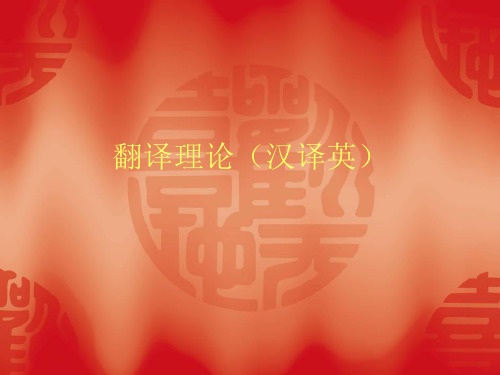
六、表示谚语的无主句英译时可译为无主句,
亦可译为人称句,要视情况而定 a)三思而后行。 First think,then speak. b)入乡随俗 When in Rome,do as the Romans do. c)活到老,学到老。 One is never too old to learn. d)不入虎穴,焉得虎子。 He who would search for pearls must dive deep.Nothing venture, nothing have.
翻译理论(汉译英)
第一章汉语单句句型的翻译(一)
第一节 无主语的译法 无主句,顾名思义,就是没有主语的句子。
英语中除谚语外,只有省略了主语的祈使句为 无主句。而汉语中无主句却比比皆是,一般用 来表示自然现象、命令、谚语、存现、叙述等 意义。汉语的无主句翻译时常采用下列方式: 一、表示自然现象,时间,距离的无主句一般 译作英语的无人称句 英语的无人称句由“代词it”作主语,其表意 功能与汉语表自然现象、时间、距离的无主句 相同,翻译时常可对译。如:
汉语的动词无词形变化,而英语的非限定动词有不 定式与分词的区别,翻译英中必须注意宾补动词形式 的运用。“使、令”类兼语式的宾补多为不定式, 有的动词只能用分词作宾朴,有的不定式,分词皆 有,意思不同,须加区别使用。 如: a)不要让你妈一直等你。 Don't keep your mother waiting. b)这话使我们都笑了。 The words set us all laughing c)他觉得房子在摇动。 He felt the house shaking 1)当动词是“keep,catch,set,feel”等时。宾补 动词应用现在分词以表进行中的动作。
翻译理论(英译汉)
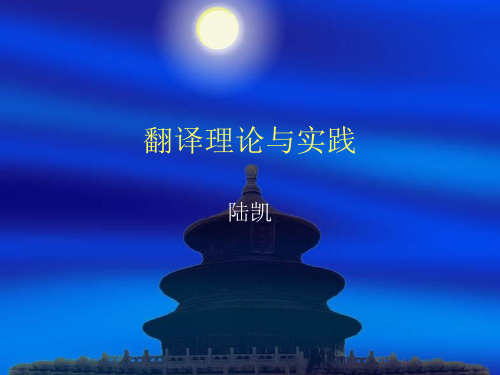
❖ (1)When the boy came back, the old man was asleep in the chair and the sun went down
❖ 孩子回来的时候,老头儿已在椅子上睡着,太阳已经西 沉了。
❖ (2)He was bending his head down,his right hand tightly clenched upon the edge of the bench.
❖ 再比如“past”这个词: ❖ (1)The days are past when Jewish blood could be
shed with impunity. ❖ 可以不受惩罚地屠杀犹太人的时代已一去不复返。
❖ (2)The old man sitting in a chair is a past president. ❖ 坐在椅子上的那位老人是一位卸任的总统。 ❖ (以上两例中past是形容词) ❖ (3)There was no question that Chrysler had a
(8)Time appears to run more slowly for a moving clock than for a clock at rest.
对于正在运动的时钟来说,时间似乎过得比静止的时 钟慢些。
(9)A fifty foot navy boat was waiting at the dock,its diesel motors running.
现在一切取决于我们打这手牌时是否冷静而审 慎。
(6)The clock hands pointed to ten minutes after five.
翻译的六大理论
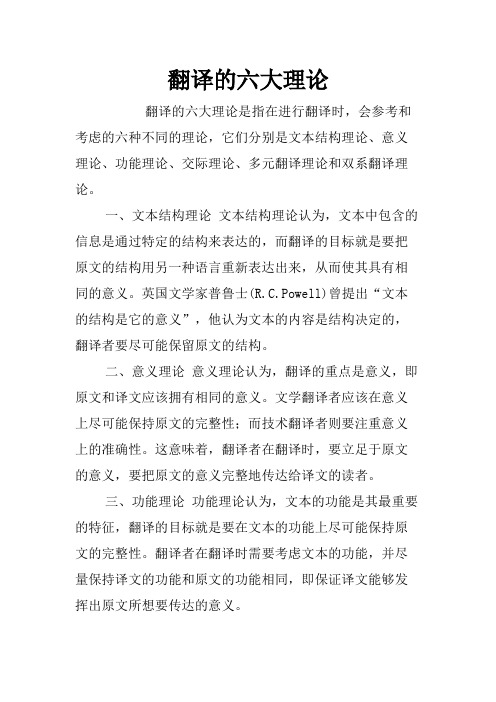
翻译的六大理论翻译的六大理论是指在进行翻译时,会参考和考虑的六种不同的理论,它们分别是文本结构理论、意义理论、功能理论、交际理论、多元翻译理论和双系翻译理论。
一、文本结构理论文本结构理论认为,文本中包含的信息是通过特定的结构来表达的,而翻译的目标就是要把原文的结构用另一种语言重新表达出来,从而使其具有相同的意义。
英国文学家普鲁士(R.C.Powell)曾提出“文本的结构是它的意义”,他认为文本的内容是结构决定的,翻译者要尽可能保留原文的结构。
二、意义理论意义理论认为,翻译的重点是意义,即原文和译文应该拥有相同的意义。
文学翻译者应该在意义上尽可能保持原文的完整性;而技术翻译者则要注重意义上的准确性。
这意味着,翻译者在翻译时,要立足于原文的意义,要把原文的意义完整地传达给译文的读者。
三、功能理论功能理论认为,文本的功能是其最重要的特征,翻译的目标就是要在文本的功能上尽可能保持原文的完整性。
翻译者在翻译时需要考虑文本的功能,并尽量保持译文的功能和原文的功能相同,即保证译文能够发挥出原文所想要传达的意义。
四、交际理论交际理论认为,翻译是一种交际行为,译文应当有效地满足读者的需求,这意味着,翻译者在翻译时,要考虑到读者的文化背景和知识水平,要尽量使译文能够被读者理解和接受。
五、多元翻译理论多元翻译理论认为,翻译不是一个简单的过程,而是一个复杂的过程,它涉及到语言、文化、历史、社会等多种因素。
翻译者要充分考虑各种因素,并尽量把原文的含义准确地传达给译文的读者。
六、双系翻译理论双系翻译理论认为,译文既要把原文的含义准确地传达给读者,又要确保译文的艺术性和可读性,从而使译文尽可能成为一种可接受的作品。
因此,翻译者在翻译时,不仅要考虑原文的内容,还要考虑译文的艺术性和可读性,从而使译文更加准确、生动、接近原文。
总而言之,翻译的六大理论是文本结构理论、意义理论、功能理论、交际理论、多元翻译理论和双系翻译理论,它们都是翻译工作中必不可少的理论,翻译者应当熟知这些理论,从而更好地完成翻译工作。
翻译理论基本原理
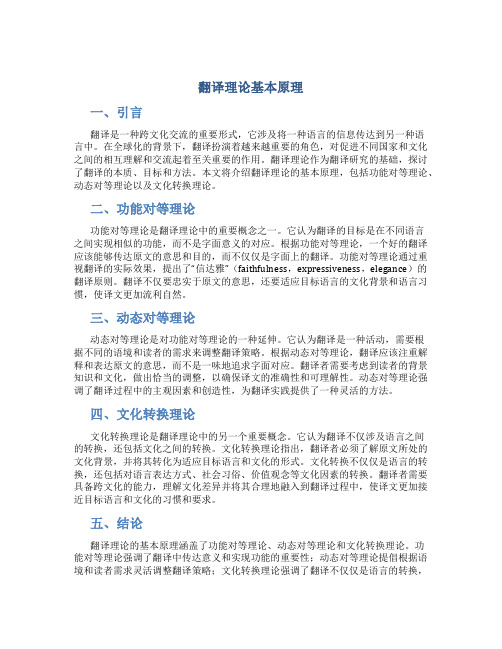
翻译理论基本原理一、引言翻译是一种跨文化交流的重要形式,它涉及将一种语言的信息传达到另一种语言中。
在全球化的背景下,翻译扮演着越来越重要的角色,对促进不同国家和文化之间的相互理解和交流起着至关重要的作用。
翻译理论作为翻译研究的基础,探讨了翻译的本质、目标和方法。
本文将介绍翻译理论的基本原理,包括功能对等理论、动态对等理论以及文化转换理论。
二、功能对等理论功能对等理论是翻译理论中的重要概念之一。
它认为翻译的目标是在不同语言之间实现相似的功能,而不是字面意义的对应。
根据功能对等理论,一个好的翻译应该能够传达原文的意思和目的,而不仅仅是字面上的翻译。
功能对等理论通过重视翻译的实际效果,提出了“信达雅”(faithfulness,expressiveness,elegance)的翻译原则。
翻译不仅要忠实于原文的意思,还要适应目标语言的文化背景和语言习惯,使译文更加流利自然。
三、动态对等理论动态对等理论是对功能对等理论的一种延伸。
它认为翻译是一种活动,需要根据不同的语境和读者的需求来调整翻译策略。
根据动态对等理论,翻译应该注重解释和表达原文的意思,而不是一味地追求字面对应。
翻译者需要考虑到读者的背景知识和文化,做出恰当的调整,以确保译文的准确性和可理解性。
动态对等理论强调了翻译过程中的主观因素和创造性,为翻译实践提供了一种灵活的方法。
四、文化转换理论文化转换理论是翻译理论中的另一个重要概念。
它认为翻译不仅涉及语言之间的转换,还包括文化之间的转换。
文化转换理论指出,翻译者必须了解原文所处的文化背景,并将其转化为适应目标语言和文化的形式。
文化转换不仅仅是语言的转换,还包括对语言表达方式、社会习俗、价值观念等文化因素的转换。
翻译者需要具备跨文化的能力,理解文化差异并将其合理地融入到翻译过程中,使译文更加接近目标语言和文化的习惯和要求。
五、结论翻译理论的基本原理涵盖了功能对等理论、动态对等理论和文化转换理论。
功能对等理论强调了翻译中传达意义和实现功能的重要性;动态对等理论提倡根据语境和读者需求灵活调整翻译策略;文化转换理论强调了翻译不仅仅是语言的转换,还涉及文化的转换。
翻译理论

翻译理论1.西方翻译理论发轫于公元前1世纪,以古罗马帝国政治家和演说家西塞罗(Cicero,前106—43)发表的《论演说术》x标志。
2.中世纪时期从西罗马帝国崩溃起(476年)至15世纪文艺复兴止。
代表人物曼里乌?波伊提乌。
3.文艺复兴时期从14世纪末起至17世纪初止,代表人物:德西德利乌?伊拉斯谟,马丁?路德和乔治?查普曼。
4.近代时期从17世纪起直至第二次世界大战结束(黄金时代)。
代表人物:约翰?德莱顿,夏尔?巴托,亚历山大?弗雷泽?泰特勒,莱尔马赫,施雷格尔(August Sxhlegel,1767--1815)和洪堡。
5.现当代翻译理论时期从第二次世界大战结束起至今。
“翻译范围之广,形式之多,规模之大,成果之丰,是历史上任何时期都不能比拟的”(谭载喜?《西方翻译史》1991),四大学派:a、布拉格学派: 创始人是马西休斯,特鲁贝茨考伊和雅可布逊. 代表人物有雅可布逊和吉里?列维、乔治?穆南、冉佩尔特、维内. 主要论点是:(一)考虑语言的各种功能;(二)重视语言的比较,包括语义、语法、语音、语言风格及文学体裁方面的比较。
b、伦敦派: 创始人是弗斯. 代表人物弗斯、卡特福德、萨瓦里和纽马克. 主要论点是:译文的选词是否与原文等同,必须看它是否用于相同的言语环境中.c、美国结构派;d、交际理论派。
6. 柯平在《西方翻译理论浅析》介绍有六大学派:a、语言学派:代表安德烈?费道罗夫和巴尔胡达罗夫。
b、交际学派:现于7、80年代,代表奈达和雷伯恩。
其理论渊源是信息论c、美国翻译研讨班学派:d、文学—文化学派;e、结构学派;f、社会符号学派。
7.布拉格学派:创始人是马西休斯(Vilem Mathesius,1882—1938)和两名俄国移民特鲁贝茨考伊(Nikolay S·Trubetskoy,1890--1938)和雅可布逊(Roman Jakobson, 1896--1982)。
主要代表人物有解渴的雅可布逊和吉里·列维(Jiri Levy)、法国的乔治·穆南(George Mounin)、德国的冉佩尔特(R·Jumpelt)、加拿大的维内(Jean-Paul Vinay),其中最有影响的是罗曼·雅可布逊和列维。
中国翻译理论简介

中国翻译理论简介中国翻译理论,从时间上看,可以分为传统、现代和当代三个时期。
在中国,传同的翻译理论是指不以西方“现代语言学”为方法论的翻译理论研究,其具体又可以分为“发生期”、“发展期”、“成熟期”、和“转型期”等。
这四个时期分别见证了中国的几大翻译高潮,即东汉至宋的佛经翻译、明末清初的科技翻译及清末明初的西学翻译及“五四”新文学翻译。
一、发生期:所谓中国翻译理论的“发生期”是指传统译论从无到有的时期,它以支谦224年的《法句经序》为肇始,而以988年的《宋高僧传.译经篇》为结束。
发生期的翻译理论建立在佛经翻译的基础上,它对于哲学、综教、文学、音乐和舞蹈都有很大影响。
发生期重要的翻译理论有如支谦的“因循本旨,不加文饰”、道安的“五失本、三不易”、玄奘的“五不翻”、颜宗的“八备说”、鸠摩罗什的“意译”主张等。
二、发展期:发展期是指传统翻译理论由简单到复杂,由低级到高级的变化过程。
这一时间中,译论家开始思考翻译的社会功能,其分别以1604年徐光启对译书目的的论述,及1894年马建忠的《拟设翻译书院议》为起止时间。
这一时期翻译的多为自然科学与社会科学的书籍,借以提高我国的综合实力。
发展期的一大典型特征便是中外翻译家的合作,期间所涌现的外籍翻译家有庞迪我、高一志、罗雅各和艾儒略等。
三、成熟期:成熟期是指传统翻译理论的完善时期,具体表现在:翻译思想日蓁充实完善,表达方法日益精密得当。
成熟期所对应的乃是西学翻译与“五四”新文学翻译,以1898年严复的《天演论》为标志,其代表性的译论有如严复的“信达雅”、林纾的谈译书之难、金岳霖的“译意”与“译味”、郑振铎的“文学可译”、矛盾的“文学翻译创造论”、鲁迅的“信译”、傅雷的“神似”与钱钟书的“化境”等。
成熟期的翻译理论研究有几个特点:翻译理论倾向的文学性质、团体论争的精彩纷呈,如严复与梁启超等关于翻译的文体、语言的论争;胡适、刘办农等对于严复、林纾的批评等、大量大翻译家及文学家的出现,如严复、矛盾、鲁迅、朱生毫等。
专业的语言翻译理论

专业的语言翻译理论语言翻译是一项重要的跨文化交流工具,能够促进不同语言和文化间的沟通。
在现代社会中,语言翻译成为了一项越来越受重视的专业领域。
本文将以专业的角度,介绍语言翻译的理论基础。
一、语言翻译的定义和作用语言翻译是指将一种语言的表达转换成另一种语言的过程。
它在国际交流、商务活动、学术研究等领域都起到了重要的作用。
语言翻译能够促进不同国家和文化之间的相互理解,促进各领域的跨国合作。
二、翻译理论的分类翻译理论可以分为三个主要的流派:等效理论、功能对等理论和目的理论。
1. 等效理论等效理论认为,在翻译过程中应当追求在目的语言中传达出与源语言相同的意义和效果。
这种理论强调在语言转换的过程中,要保持两种语言之间的等效性,使译文具有与源语言相同的效果。
2. 功能对等理论功能对等理论强调的是根据接受者的需求和情景,调整译文的形式和内容,以传达源语言的目的和意图。
这种理论认为,翻译的目标是满足接受者的需求,同时适应不同的文化环境。
3. 目的理论目的理论认为,翻译的目标是实现某种特定的效果,通过翻译来实现特定的目的。
这种理论强调的是对翻译目标的思考和理解,以此来确定翻译的策略和方法。
三、翻译的基本原则无论是哪种翻译理论,都需要依赖一些基本的原则来指导翻译实践。
以下是几个常用的翻译原则:1. 信实原则翻译应该忠实于原文的内容和意图,不能随意增删或改变原文的信息。
2. 通顺原则译文应该符合目标语言的语法规则和表达习惯,以使译文通顺自然。
3. 文化适应原则翻译应该根据不同的文化背景,对原文的内容进行调整和适应,使译文更符合目标读者的文化环境。
4. 语法准确原则翻译应该遵循目标语言的语法规则,保证译文的语言结构正确。
五、专业翻译的要求和技巧作为一名专业的翻译人员,需要具备以下几方面的要求和技巧:1. 语言能力:掌握专业的目标语言和源语言,运用恰当的词汇和语法结构进行翻译。
2. 文化背景:了解源语言和目标语言的文化差异,能够在翻译过程中针对不同文化背景进行调整。
翻译理论总结期末
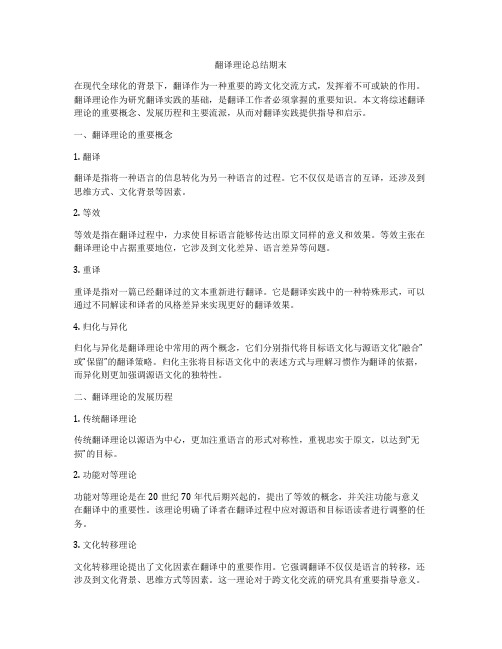
翻译理论总结期末在现代全球化的背景下,翻译作为一种重要的跨文化交流方式,发挥着不可或缺的作用。
翻译理论作为研究翻译实践的基础,是翻译工作者必须掌握的重要知识。
本文将综述翻译理论的重要概念、发展历程和主要流派,从而对翻译实践提供指导和启示。
一、翻译理论的重要概念1. 翻译翻译是指将一种语言的信息转化为另一种语言的过程。
它不仅仅是语言的互译,还涉及到思维方式、文化背景等因素。
2. 等效等效是指在翻译过程中,力求使目标语言能够传达出原文同样的意义和效果。
等效主张在翻译理论中占据重要地位,它涉及到文化差异、语言差异等问题。
3. 重译重译是指对一篇已经翻译过的文本重新进行翻译。
它是翻译实践中的一种特殊形式,可以通过不同解读和译者的风格差异来实现更好的翻译效果。
4. 归化与异化归化与异化是翻译理论中常用的两个概念,它们分别指代将目标语文化与源语文化“融合”或“保留”的翻译策略。
归化主张将目标语文化中的表述方式与理解习惯作为翻译的依据,而异化则更加强调源语文化的独特性。
二、翻译理论的发展历程1. 传统翻译理论传统翻译理论以源语为中心,更加注重语言的形式对称性,重视忠实于原文,以达到“无损”的目标。
2. 功能对等理论功能对等理论是在20世纪70年代后期兴起的,提出了等效的概念,并关注功能与意义在翻译中的重要性。
该理论明确了译者在翻译过程中应对源语和目标语读者进行调整的任务。
3. 文化转移理论文化转移理论提出了文化因素在翻译中的重要作用。
它强调翻译不仅仅是语言的转移,还涉及到文化背景、思维方式等因素。
这一理论对于跨文化交流的研究具有重要指导意义。
4. 重译和再翻译理论重译和再翻译理论强调翻译是一个不断发展的过程,通过对已有翻译作品的再审视和重新翻译,可以实现更好的翻译效果。
这一理论提醒翻译者不仅要注重翻译策略,还要不断提升自己的翻译水平。
三、翻译理论的主要流派1. 源语导向理论源语导向理论以源语为中心,强调翻译要忠实于原文,力求实现“无损”翻译。
翻译理论
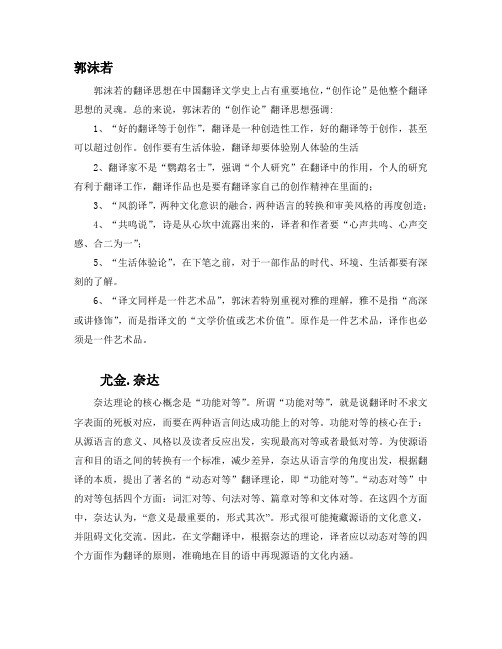
郭沫若的翻译思想在中国翻译文学史上占有重要地位,“创作论”是他整个翻译思想的灵魂。
总的来说,郭沫若的“创作论”翻译思想强调:1、“好的翻译等于创作”,翻译是一种创造性工作,好的翻译等于创作,甚至可以超过创作。
创作要有生活体验,翻译却要体验别人体验的生活2、翻译家不是“鹦鹉名士”,强调“个人研究”在翻译中的作用,个人的研究有利于翻译工作,翻译作品也是要有翻译家自己的创作精神在里面的;3、“风韵译”,两种文化意识的融合,两种语言的转换和审美风格的再度创造;4、“共鸣说”,诗是从心坎中流露出来的,译者和作者要“心声共鸣、心声交感、合二为一”;5、“生活体验论”,在下笔之前,对于一部作品的时代、环境、生活都要有深刻的了解。
6、“译文同样是一件艺术品”,郭沫若特别重视对雅的理解,雅不是指“高深或讲修饰”,而是指译文的“文学价值或艺术价值”。
原作是一件艺术品,译作也必须是一件艺术品。
尤金.奈达奈达理论的核心概念是“功能对等”。
所谓“功能对等”,就是说翻译时不求文字表面的死板对应,而要在两种语言间达成功能上的对等。
功能对等的核心在于:从源语言的意义、风格以及读者反应出发,实现最高对等或者最低对等。
为使源语言和目的语之间的转换有一个标准,减少差异,奈达从语言学的角度出发,根据翻译的本质,提出了著名的“动态对等”翻译理论,即“功能对等”。
“动态对等”中的对等包括四个方面:词汇对等、句法对等、篇章对等和文体对等。
在这四个方面中,奈达认为,“意义是最重要的,形式其次”。
形式很可能掩藏源语的文化意义,并阻碍文化交流。
因此,在文学翻译中,根据奈达的理论,译者应以动态对等的四个方面作为翻译的原则,准确地在目的语中再现源语的文化内涵。
叶君健的主要翻译理论是“精品论”。
1、译者介入——“我们需要有个性的译作”。
翻译不能说是“复制”,而确有“再创造”的一面,因而也是一种文学“创作”。
因此,译者的个人因素在翻译工作中所起的作用,是决不能忽视的。
翻译理论(英文)课件

感谢观看
Translation Theory (English) Courseware
Overview of Translation TheoryFunctional Translation TheoryCultural Translation TheoryCorpus Translation TheoryMachine Translation TheorySummary and Outlook
详细描述
翻译理论的主要流派包括形式对应、动态对应、功能对应等。
总结词
形式对应理论强调翻译过程中原文和译文在形式上的对应,要求译文尽可能忠实于原文的形式和内容。动态对应理论则强调译文读者对译文的反应要与原文读者对原文的反应一致,注重语篇层面的意义传递。功能对应理论则认为翻译的首要任务是实现原文的功能,如信息传递、情感表达等,强调译文的交际功能。这些流派各有侧重,共同构成了翻译理论的丰富多样性。
详细描述
Functional Translation Theory
02
总结词
功能翻译理论是一种强调翻译功能和目的的理论,它认为翻译不仅是语言之间的转换,更是文化交流和信息传递的过程。
详细描述
功能翻译理论强调翻译的功能性和目的性,认为翻译的目的是为了实现源语文本在目标文化中的特定功能。它强调翻译过程中对目标读者需求的关注,以及对目标语言和文化背景的考虑。
Machine Translation Theory
05
机器翻译理论是指利用计算机技术实现自然语言之间的自动翻译的理论。
定义
特点
适用范围
高效、快速、自动化、多语言支持。
广泛应用于国际交流、跨语言信息检索、全球化企业等领域。
(完整版)翻译理论
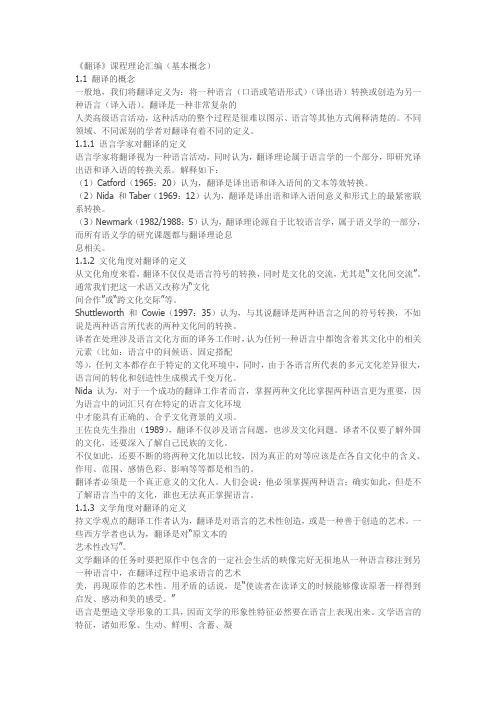
《翻译》课程理论汇编(基本概念)1.1 翻译的概念一般地,我们将翻译定义为:将一种语言(口语或笔语形式)(译出语)转换或创造为另一种语言(译入语)。
翻译是一种非常复杂的人类高级语言活动,这种活动的整个过程是很难以图示、语言等其他方式阐释清楚的。
不同领域、不同派别的学者对翻译有着不同的定义。
1.1.1 语言学家对翻译的定义语言学家将翻译视为一种语言活动,同时认为,翻译理论属于语言学的一个部分,即研究译出语和译入语的转换关系。
解释如下:(1)Catford(1965:20)认为,翻译是译出语和译入语间的文本等效转换。
(2)Nida 和Taber(1969:12)认为,翻译是译出语和译入语间意义和形式上的最紧密联系转换。
(3)Newmark(1982/1988:5)认为,翻译理论源自于比较语言学,属于语义学的一部分,而所有语义学的研究课题都与翻译理论息息相关。
1.1.2 文化角度对翻译的定义从文化角度来看,翻译不仅仅是语言符号的转换,同时是文化的交流,尤其是“文化间交流”。
通常我们把这一术语又改称为“文化间合作”或“跨文化交际”等。
Shuttleworth 和Cowie(1997:35)认为,与其说翻译是两种语言之间的符号转换,不如说是两种语言所代表的两种文化间的转换。
译者在处理涉及语言文化方面的译务工作时,认为任何一种语言中都饱含着其文化中的相关元素(比如:语言中的问候语、固定搭配等),任何文本都存在于特定的文化环境中,同时,由于各语言所代表的多元文化差异很大,语言间的转化和创造性生成模式千变万化。
Nida 认为,对于一个成功的翻译工作者而言,掌握两种文化比掌握两种语言更为重要,因为语言中的词汇只有在特定的语言文化环境中才能具有正确的、合乎文化背景的义项。
王佐良先生指出(1989),翻译不仅涉及语言问题,也涉及文化问题。
译者不仅要了解外国的文化,还要深入了解自己民族的文化。
不仅如此,还要不断的将两种文化加以比较,因为真正的对等应该是在各自文化中的含义、作用、范围、感情色彩、影响等等都是相当的。
中国的翻译理论简介

著名文学翻译家鲁迅
傅雷主要译作:伏尔泰、巴尔扎克、罗曼·罗兰 的重要作品。有《约翰·克利斯朵夫》 、传记 《贝多芬传》 、 《托尔斯泰传》 、 《米开朗琪 罗传》;巴尔扎克名著《高老头》 、 《欧也 妮·葛朗台》 、 《贝姨》 、 《邦斯舅舅》 、 《夏倍上校》 、 《幻灭》 ;伏尔泰的《老实 人》 、 《天真汉》 ;梅里美的《嘉尔曼》 、 《高龙巴》等等共三十余部作品。
南怀仁
南怀仁为清朝廷制造的6件天文仪器,至今还保存 在北京古观象台上。在南怀仁逝世300周年的时候, 中国政府向比利时鲁汶大学南怀仁基金会赠送了 “天球仪”(即南怀仁设计制造的大型天文仪器之 一)的模型,至今保存在南怀仁厅前。
比利时鲁汶大学建立的怀仁厅
中国近代翻译家之一:严复
严复(1854年1月8日-1921年10月27日)乳名体干,初名传初, 改名宗光,字又陵,后名复,字几道,晚号野老人,福建侯官 (后并入闽县,称为闽侯,今福州市)人。他系统地将西方的社 会学、政治学、政治经济学、哲学和自然科学介绍到中国,是清 末很有影响的资产阶级启蒙思想家,翻译家和教育家,是中国近 代史上向西方国家寻找真理的“先进的中国人”之一。
二十世纪中国学派的六大翻译理论
第一个翻译理论家是严复,他在《天演论》(Evolution and Ethics and other Essays)中提 出了“译事有三难:信、达、雅”( faithfulness, expressiveness, elegance) ,即“信、 达、雅”三原则。这三个字的影响之大,可以说是“世界之罪”。因为二十世纪的中国译 者几乎没有不受这三个字影响的 (已衍生出“信达切”(刘重德)、“信达贴”(蔡思果)、 “信达优”(许渊冲)、“信达似”(裘克安)、信达+X等) 。“信”是强调译文必须忠 实于原文,“达”是强调译文应该通顺易懂,“雅”在严复时代指的是桐城派风格,现在 一般赋予“雅”新的涵义,即要求译文有文才。
翻译理论名词解释
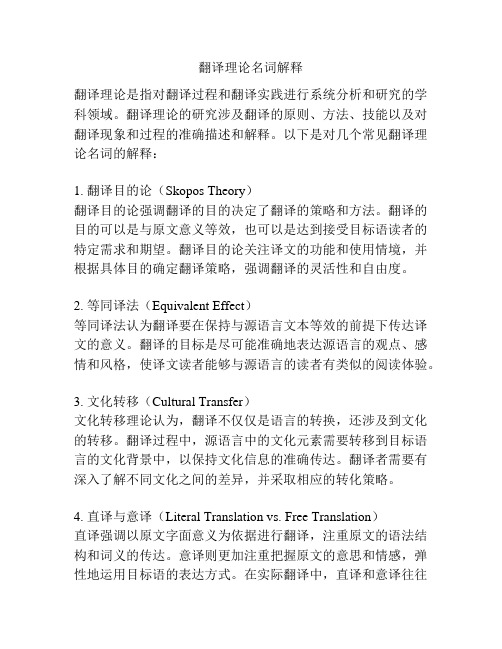
翻译理论名词解释翻译理论是指对翻译过程和翻译实践进行系统分析和研究的学科领域。
翻译理论的研究涉及翻译的原则、方法、技能以及对翻译现象和过程的准确描述和解释。
以下是对几个常见翻译理论名词的解释:1. 翻译目的论(Skopos Theory)翻译目的论强调翻译的目的决定了翻译的策略和方法。
翻译的目的可以是与原文意义等效,也可以是达到接受目标语读者的特定需求和期望。
翻译目的论关注译文的功能和使用情境,并根据具体目的确定翻译策略,强调翻译的灵活性和自由度。
2. 等同译法(Equivalent Effect)等同译法认为翻译要在保持与源语言文本等效的前提下传达译文的意义。
翻译的目标是尽可能准确地表达源语言的观点、感情和风格,使译文读者能够与源语言的读者有类似的阅读体验。
3. 文化转移(Cultural Transfer)文化转移理论认为,翻译不仅仅是语言的转换,还涉及到文化的转移。
翻译过程中,源语言中的文化元素需要转移到目标语言的文化背景中,以保持文化信息的准确传达。
翻译者需要有深入了解不同文化之间的差异,并采取相应的转化策略。
4. 直译与意译(Literal Translation vs. Free Translation)直译强调以原文字面意义为依据进行翻译,注重原文的语法结构和词义的传达。
意译则更加注重把握原文的意思和情感,弹性地运用目标语的表达方式。
在实际翻译中,直译和意译往往是结合使用的,翻译者需要根据具体文本和翻译目标选择合适的翻译策略。
5. 动态对等(Dynamic Equivalence)动态对等理论认为,翻译应该追求与源语文本相同的效果和反应,而不仅仅是对原文进行语义层面的等效翻译。
翻译的目标是在目标语的文化和语境中呈现出与源语文本相似的意义和效果。
翻译理论的不断发展和完善,为翻译实践提供了理论指导和操作方法。
翻译理论的研究对于提高翻译质量、促进跨文化交流以及研究语言和文化之间的关系具有重要意义。
翻译理论的作用认识

02 03
语料库与计算机辅助翻译
基于语料库的翻译研究和计算机辅助翻译工具的发展为翻 译理论提供了新的途径。通过大规模语料的分析和处理, 可以更好地理解翻译过程中的规律和现象。
翻译伦理与文化交流
随着全球化的深入,翻译理论越来越关注翻译在文化交流 和传播中的作用,如何处理翻译中的文化差异和冲突成为 研究的重点。同时,翻译伦理也受到越来越多的关注,如 译者的责任、知识产权等问题。
服务经济发展
03
翻译理论有助于提高科技翻译的质量和水平,为经济
发展提供有力的支持和服务。
05 翻译理论的挑战与发展趋 势
翻译理论的现有问题与挑战
01
翻译标准的界定
02
翻译过程的复杂性
翻译理论目前面临的问题之一是翻译 标准的确定。翻译标准是衡量翻译质 量的重要尺度,但不同的文化背景、 语言类型和翻译目的使得翻译标准难 以统一。
翻译理论分类
翻译理论可以根据不同的标准进行分类,如根据研究重点、学科领域、适用范 围等。常见的分类包括:语言学翻译理论、文学翻译理论、跨文化翻译理论等 。
翻译理论的发展历程
古代翻译理论
古代的翻译理论主要基于经验和传统,如古希腊的翻译理论 、中国的佛经翻译理论等。这些理论注重传达原文的意义和 精神,而非语言层面的对应。
传承历史文化
翻译理论有助于传承和弘 扬历史文化,让更多人了 解和认识历史文化遗产的 价值。
翻译理论在科技翻译中的应用
传递科技信息
01
翻译理论可以帮助我们准确传递科技信息,促进科技
交流和发展。
促进科技创新
02 通过翻译理论,我们可以更好地理解和掌握国际先进
的科技成果和经验,为我国的科技创新提供支持。
纽马克翻译理论

纽马克翻译理论纽马克翻译理论是由美国翻译学家劳维·纽马克于1966年提出的,是对翻译过程中不同语言之间的差异进行思考和研究的理论体系。
该理论主张翻译是一个复杂的思维活动,不仅是为了传递信息,还包括对原文语境、文化背景和意义的理解与转换。
纽马克翻译理论的核心观点是“等效”,即在翻译过程中要寻求源语和译语之间的最佳对等关系。
这种对等关系不仅仅是词语的对应,还包括语法结构、句子成分、篇章结构和文化背景等方面的对等。
纽马克认为,在译语中只有找到和源语尽可能相近的等效元素,才能更好地传达原文的意义和信息。
纽马克翻译理论还注重对源语与译语的交互作用进行分析。
他认为翻译不是简单的单向转换过程,而是源语和译语之间的双向互动。
翻译过程中,译者需要根据源语的信息和结构来生成译文,同时还需要在译语中反映出自己的思维和文化背景。
这种双向互动使得翻译过程更丰富、灵活,使译文更贴近译者的认知和表达方式。
另外,纽马克翻译理论还强调了语境的重要性。
他认为在翻译过程中,必须考虑到源语和译语之间的语境差异,并在译文中重新建立适当的语境。
语境包括文化背景、社会环境、语用规范等各种因素,影响着信息的传递和接收。
因此,翻译者需要具备广泛的知识背景,能够理解并恰当地转换这些语境因素,从而保证译文的准确性和通达性。
纽马克翻译理论的意义在于提供了一种系统的翻译思路和方法,为翻译实践提供了理论指导。
该理论强调了翻译过程中的主观能动性和交互性,强调了译者对语境的敏感度和理解力,使得翻译不再是简单的语义转换,而是一种更加复杂的思维和沟通活动。
此外,纽马克翻译理论的强调了译文的灵活性和可变性,使得翻译不再受限于严格的对等要求,而是可以根据不同翻译目的和接受者的需求进行调整和变化。
总而言之,纽马克翻译理论是对翻译过程中语言差异与等效关系的思考和研究,强调了翻译是一种复杂的思维活动,需要考虑到语境和文化背景等因素。
该理论为翻译实践提供了理论支持和指导,使译者能够更加准确地传达源语的意义和信息。
翻译理论简介

主张直译的鲁迅,矛盾,释道安:东晋前秦时高僧,主张直译,译文不增不减只在词序上作些调整;玄zhuang: 唐高僧,倾向于直译,“既须求真,又须喻俗”。
矛盾:主张直译,同时又提倡保留“神韵”。
关于直译直译就浅处说,是“不妄改原文的字句”,就深处说,还求“能保留原文的情调与风格”。
赵景深“宁顺而不信”鲁迅“宁信而不顺”,强调要输入新的表现法所以现在要容ren“多少的不顺”。
主张直译瞿秋白:信和顺不应当对立起来。
鲁迅:“凡是翻译,必须兼顾着两面,一当然要力求其易解,一则保存着原作的丰姿”,也就是说,翻译既要通顺,又要忠实。
主张意译的:鸠摩罗什:后秦高僧。
倾向于意译,常对原文加以改动,以适应中国的文体。
严复;信(忠实)达(流畅)雅(尔雅)周煦良:“信达雅哪个最重要?要看内容而定。
一篇译文如果在内容上是忠实的,在语言上是通顺的,在风格上是得体的,那的确就是一篇好译文了。
林纾:以文言文翻译欧美小说184种。
G ulliver’s Travels, 海外轩渠录David Copperfield块肉余生述Oliver Twist贼史钱钟书:在“林杼的翻译”一文中,提出“文学翻译的最高标准是化,把一国的文学作品译成另一国文字,既能不因语言习惯的差异而露出生硬牵强的痕迹,又能完全保存原有的风味,那就算“入得化境”。
(仅限于文学作品)郭沫若“好的翻译等于创作,甚至可能超过创作““信达雅确实是必要条件,……尤其是文学作品,信达之外,愈雅愈好”认为直译和意译是一回事的四五十年代:朱光潜:“直译不能不是意译,而意译也不能不是直译”林汉达:“正确的翻译分不出直译或者意译”周建人:直译不是“字典译法,也不是……它是要求真正的意译七八十年代:周煦良:直译的毕竟是少数许渊冲:哪种方式有力有哪种王佐良:“凡能直译处坚持直译,必须意译处则放手意译“适合就是一切“傅雷:“重神似不重形似“翻译重在实践”“得其精而忘其粗,在其内而忘其外”“关于风格:支持能译的:矛盾、是“不妄改原文的字句”,就深处说,还求“能保留原文的情调与风格”。
翻译有哪些理论

翻译有哪些理论翻译学中的理论有很多,以下是其中的一些主要理论:1.等效理论(Equivalence Theory):由Eugene Nida和Charles Taber于1960年提出。
该理论认为翻译的目标是在不同语言之间传达与源文本相等或相似的意义。
它强调翻译的等级和程度,分为准确传递(充分等效)、部分传递(偏远等效)和恢复信息(零等效)。
2.功能对等理论(Functional Equivalence Theory):由Christiane Nord于1991年提出。
该理论认为翻译的目标是根据目标语言和文化的读者需求,在功能上等效于源文本。
它强调翻译的目的是满足读者对论述、表述和信息的期望,并做出相应调整。
3.文化翻译理论(Cultural Translation Theory):由AndréLefevere于1992年提出。
该理论认为翻译是一种文化间的传递和变革过程,强调翻译的文化因素对于意义的建构和解读至关重要。
它探讨了源文本和目标文本之间的文化差异,并提出了译者作为文化中介者的角色。
4.再现理论(Relevance Theory):由Dan Sperber和Deirdre Wilson于1986年提出。
该理论认为翻译的目标是传递有效沟通所需的信息,并尽可能减少读者的认知努力。
它强调翻译要遵循言语交际原则,提供最相关和最明确的信息,以确保双方的理解和交流。
5.干扰理论(Interference Theory):源于歧义和误会的语言干扰现象。
干扰理论认为翻译是在源语言和目标语言之间进行的,源语言结构和表达方式会对译文产生不同程度的影响。
干扰理论研究译者如何解决干扰问题,以确保翻译的准确性和流畅性。
6.社会文化理论(Sociocultural Theory):由Lev Vygotsky于20世纪初提出。
社会文化理论认为翻译是一种社会和文化实践,翻译活动受到社会环境和文化背景的影响。
它研究翻译与社会和文化因素之间的相互关系,强调译者的角色和社会文化认知对翻译的重要性。
- 1、下载文档前请自行甄别文档内容的完整性,平台不提供额外的编辑、内容补充、找答案等附加服务。
- 2、"仅部分预览"的文档,不可在线预览部分如存在完整性等问题,可反馈申请退款(可完整预览的文档不适用该条件!)。
- 3、如文档侵犯您的权益,请联系客服反馈,我们会尽快为您处理(人工客服工作时间:9:00-18:30)。
The application of translation theoryAbstractAfter one and a half year’s study of translation theory, although not as professional as some peers, I am able to have a scarce access to the mainstream translation theories around the world. In spite of still not being able to put forward some new theories, I have some opinions toward the application of translation theory. As a translation major, making full use of translation theories to facilitate translating is of great significance. The essay will try to elaborate on the benefits of application of multiple translation theories when translating a text from three aspects, breaking the fetters of a single theory.Keyword: application, multiple translation theories, optimizeThe old theory has been out of date and more new theories need to be adopted. The world is changing. So does translation theory. “Faithfulness, expressiveness and elegance” put forward by Yan Fu are very useful when applied to the translation in his century under the condition of his times. However, it is not absolutely wrong to use Yan Fu’s theory in our times, but we need to adopt some new theories to meet the needs of the development. For example: when translating the Chinese brand “白熊” to English, which one should we adopt? “White Bear” or“Polar Bear”? As is known to all, “Polar Bear” is a nickname of Russia internationally. Therefore, it is better to be translated into “White Bear”. Likewise, considering the different images of dragon in Chinese culture and western culture, “金龙” is better to be translated as “King Long”instead of “Golden Dragon”, for dragon in China represents luck and sacredness while in western countries stands for devil and monster. Clearly, in the translation of advertisement, Yan Fu’s faithfulness is no longer applicable. Consequently, with the development of the society, translation theory needs to be updated, which requires translators to learn more new theories and use them to direct translation process.With application of multiple theories, the final translated version can be optimized. The function of a translation theory is not only to direct translation process but also to help evaluate the final version. Gutt in his relevance theory states that human communication crucially creates an expectation of optimal relevance, that is, an expectation on the part of the hearer that his attempt at interpretation will yield adequate contextual effects at minimal processing cost①. The author would like to draw an analogy from his theory and make a conclusion that the aim of applying multiple translation theories in translating process is to reach an optimal final version at the expense of minimal evaluating cost. If a final translated version can meet the demand of multiple theories, then it must be the best. For example, if a translated version can not only be faithful, expressive and elegance but also meet the requirements of fictional equivalence, then it must be better. Of course, sometimes, although not all the criteria are met, we have to try to optimize it anyway.From the aspect of translation criticism, accessing a translation with multiple theories and allowing different opinions can avoid subjectivity, which gives the readers more freedom to choose the best translations without misleading. Mary Snell-hornby says in her book that Translation studies have been hampered by classical modes of categorization, which operate with rigid dividing-lines, binary opposites, antitheses and dichotomies. Frequently there are mere academic constructs which paralyze the finer differentiation required in all aspects of translation studies②. It is quite common that in China, many scholars still stick to some old theories and apply them to all kinds of texts in translation③. Even though some are able to make a step and learn some new theories from western countries, usually they are just a proponent of only one theory, criticizing others’. It is time to be open and general. With the help of multiple theories, a translated version can be accessed from different aspects. Therefore, it is more objective for a translator to evaluate a translated version using different theories. As a result, the readers are able to make their own judgment, considering various aspects.ConclusionWith the development of the society, the application of translation theory is no longer limited to single one but multiple ones. This essay explains in detail why multiple translation theories should be applied when translating from three aspects. First, the old theory has been out of date and more new theories need to be adopted. Second, with application of multiple theories, the final translated version can be optimized. Third, from the aspect of translation criticism, accessing a translation with multiple theories and allowing different opinions can avoid subjectivity, which gives the readers more freedom to choose the best translations without misleading. It is time to be open and allow existence of multiple theories to direct our translation.Bibliography①Ernst-August Gutt, 2009, Translation and relevance-Cognition and context, 上海外语教育出版社,上海,第32页②Mary Snell-hornby, 2007, Translation studies-An integrated approach,上海外语教育出版社,上海,第35页③王树槐.,2001,关于本科翻译教学的思考,中国翻译, 上海。
